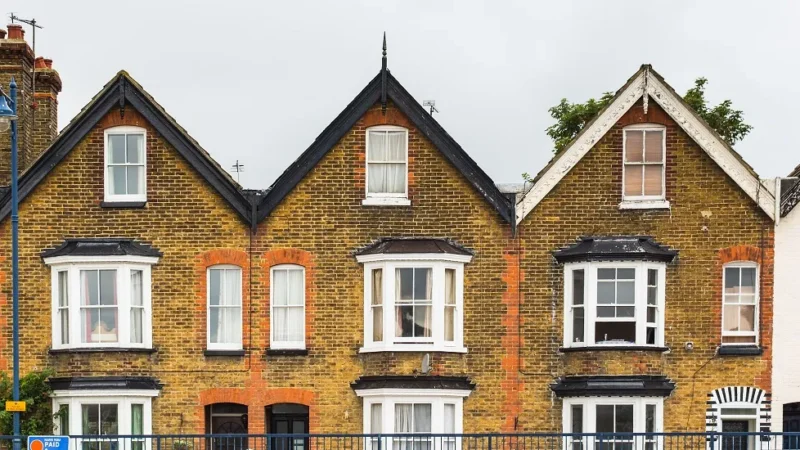How To Buy A House In The UK

Table of Contents
ToggleBuying House in UK Process -
When purchasing a house in the UK, it’s essential to understand the process and the key factors involved. A house is a significant financial decision that requires careful consideration and planning. Whether you’re a first-time buyer or looking to move to a new property, this introduction will provide an overview of what to expect when buying a house in the UK.
The UK property market offers many options, from apartments in bustling cities to cozy cottages in rural areas. However, navigating the buying process can be complex, so educating yourself about the steps involved is essential to make informed decisions.
Understanding the housing market is crucial before embarking on your house-hunting journey. Location, property prices, and market trends will influence your choices and affordability. Moreover, determining your budget is a fundamental step in the process. You must assess your financial situation, including income, savings, and any outstanding debts or financial commitments.
Financing plays a vital role in buying a house. In the UK, most people rely on mortgages to fund their property purchases. Familiarize yourself with different mortgage options, such as fixed-rate, variable-rate, and help-to-buy schemes, to find the most suitable one for your needs. Securing financing involves several stages, including pre-approval, mortgage applications, and possibly consulting with a mortgage advisor.
Once you clearly understand your budget and financing options, it’s time to search for your dream home. Conduct thorough online and offline research on the housing market, and consider factors like property size, location, amenities, and proximity to essential facilities. Engaging with estate agents, attending open houses, and using property search websites can provide valuable insights into available properties.
When you find a property that meets your requirements, making an offer and negotiating with the seller or estate agent is the next step. Conducting property surveys and valuations can help identify any potential issues or discrepancies. It’s important to be aware of the legal process, such as conveyancing, which involves solicitors or conveyancers handling property searches, contracts, and the exchange of contracts.
Completing the purchase involves finalizing all the necessary paperwork, coordinating with your mortgage lender, and preparing for completion day. Additionally, you’ll need to consider additional costs associated with buying a house in the UK, such as Stamp Duty Land Tax (SDLT), legal fees, surveys, and moving expenses.
Once the purchase is complete, it’s time to move into your new home and settle down. This includes organizing the move, changing addresses, setting up utilities and services, and making your new house feel like a home. Getting to know the local community and making connections can help you settle into your new surroundings.
Buying a house in the UK is a significant milestone, and understanding the process will empower you to make informed decisions and navigate the market effectively. The following sections will delve deeper into each step, providing valuable information and tips to help you.
Determining Your Budget -
Before diving into the process of buying a house in the UK, it’s crucial to determine your budget. Understanding how much you can afford to spend will guide your property search and ensure you don’t overextend yourself financially. Here are some important factors to consider when determining your budget:
1: Assess Your Financial Situation: Begin by assessing your overall financial situation. Consider your income, savings, and any outstanding debts or financial commitments. This will give you a clear picture of your current financial standing and help you determine how much you can allocate toward a house purchase.
2: Calculate Affordability: Affordability is a key aspect of determining your budget. Generally, it is recommended that your monthly housing expenses (including mortgage payments, property taxes, and insurance) should not exceed 30-35% of your gross monthly income. Use this guideline as a starting point to calculate the maximum amount you can comfortably afford to spend on housing each month.
3: Consider Additional Costs: Apart from the house’s purchase price, there are other costs to factor into your budget. These include legal fees, property surveys, Stamp Duty Land Tax (SDLT), mortgage arrangement fees, and potential renovation or repair costs. Research and estimate these costs to understand the overall expenses involved in buying a house.
4: Get Pre-Approved for a Mortgage:Getting pre-approved for a mortgage is a smart move that helps you determine your budget accurately. Mortgage lenders will assess your financial details and provide a pre-approval letter indicating the maximum amount they will lend you. This information is valuable as it narrows your search to properties within your price range.
5: Plan for Future Expenses:It’s important to consider your long-term financial goals and any future expenses that may impact your budget. For example, if you plan to start a family, save for retirement, or pursue other significant investments, consider these future financial commitments when determining your budget. This will ensure that your house purchase remains sustainable in the long run.
6: Be Realistic:While it’s natural to aspire to your dream home, it’s essential to be realistic about what you can afford. Remember that your budget will influence the type, size, and location of the properties you can consider. Setting realistic expectations will help you avoid disappointment and find a home that fits your financial capabilities.
Considering these factors, you can determine a realistic budget for your house purchase in the UK. Remember, buying a house is a long-term financial commitment, so ensuring that your budget aligns with your financial goals and provides a comfortable living situation is crucial.
Researching the Housing Market -
When buying a house in the UK, thorough housing market research is essential. Understanding the market conditions, trends, and factors influencing property prices will empower you to make informed decisions. Here are some key aspects to consider when researching the housing market:
- Location:Start by researching different locations that interest you. Consider factors such as proximity to your workplace, transportation links, schools, amenities, and the overall desirability of the area. Property prices vary significantly based on location, so understanding the local market dynamics is crucial.
- Property Prices:Look into property prices in the areas you’re interested in. Online property portals, estate agent websites, and local property price indices can provide valuable information. Compare the prices of similar properties in different locations to get an idea of the price range you can expect. Additionally, track historical price trends to identify any fluctuations or patterns in the market.
- Market Trends:Stay up to date with current market trends and forecasts. Monitor news articles, and reports from reputable property market analysts, and industry publications. These sources often provide insights into factors influencing the housing market, such as economic conditions, interest rates, government policies, and demographic shifts. Understanding these trends can help you make strategic decisions regarding the timing of your purchase.
4: Supply and Demand: Analyze the supply and demand dynamics in the areas you’re interested in. Look for information on the number of properties listed for sale versus the number of buyers in the market. High demand and limited supply can drive prices up, while a surplus of available properties may create opportunities for negotiation.
5: Local Amenities and Infrastructure: Assess the amenities and infrastructure in the areas you’re considering. This includes schools, healthcare facilities, parks, shopping centers, public transportation, and future development plans. Properties in areas with good amenities and convenient access to essential facilities hold their value better over time.
6: Consult Estate Agents: Engage with local estate agents with in-depth market knowledge. They can provide insights into specific areas, property types, and recent transactions. Estate agents can also notify you of new properties coming onto the market before they are publicly listed, giving you a potential advantage in finding your dream home.
7: Property Viewing and Open Houses: Attend property viewings and open houses to understand the local property market firsthand. This will allow you to compare different properties, assess their condition, and gauge their value. It’s also an opportunity to ask questions, gather information, and better understand what you can expect within your budget.
Remember to keep track of the information you gather during your research. Create spreadsheets or use online tools to organize property details, prices, and other relevant data. This will help you make informed comparisons and decisions when the time comes to make an offer.
Securing Financing and Mortgage Options -
Securing financing is crucial in buying a house in the UK, as most buyers rely on mortgages to fund their purchases. Understanding the different mortgage options available and going through the process of obtaining a mortgage will help you determine your purchasing power and find the most suitable financing option. Here are the key steps to securing financing:
- Assess Your Financial Situation:Before approaching mortgage lenders, assess your financial situation. Consider your income, savings, and any outstanding debts or financial commitments. This information will help determine your affordability and the amount you can comfortably borrow.
- Research Mortgage Options:Familiarize yourself with the various mortgage options available in the UK. The most common types include fixed-rate mortgages, where the interest rate remains constant for a specified period, and variable-rate mortgages, where the interest rate can fluctuate. Additionally, explore government-backed schemes like the Help to Buy scheme, shared ownership, or shared equity mortgages. Each option has pros and cons, so research and compare to find the most suitable option.
- Get Pre-Approved:Consider getting pre-approved for a mortgage before starting your property search. Pre-approval involves a lender assessing your financial details and providing a pre-approval letter indicating the maximum amount they are willing to lend you. Pre-approval gives you a clear understanding of your budget, strengthens your offer when making an offer on a property, and streamlines the process once you find your ideal home.
- Find a Mortgage Advisor:Working with a mortgage advisor can be beneficial, especially if navigating the mortgage process for the first time or having unique financial circumstances. Mortgage advisors have access to a wide range of mortgage products and can provide expert advice tailored to your needs. They can guide you through the application process, help you compare offers, and handle paperwork on your behalf.
- Gather Necessary Documentation:When applying for a mortgage, you must provide supporting documentation, such as proof of income (pay stubs, tax returns), bank statements, identification documents, and details of your financial commitments. Organize these documents in advance to streamline the application process.
6: Compare Lenders and Rates: Shopping around and comparing mortgage lenders is essential to ensure you secure the most favorable terms and interest rates. When evaluating lenders, consider factors such as interest rates, repayment terms, fees, and customer service. Online mortgage comparison tools and speaking to multiple lenders directly can help you make an informed decision.
7: Complete the Mortgage Application: Once you’ve selected a lender, complete the mortgage application. Provide accurate information about your financial situation, employment history, and the property you intend to purchase. The lender will review your application, conduct a credit check, and assess your eligibility for the mortgage.
8: Mortgage Valuation and Survey: As part of the mortgage process, the lender may require a mortgage valuation or survey to assess the value and condition of the property. A surveyor appointed by the lender typically carries out the valuation. You may also consider getting a more detailed survey, such as a homebuyer’s report or a full structural survey, to comprehensively understand the property’s condition.
8: Mortgage Offer: If the lender is satisfied with the valuation and survey reports and approves your application, they will offer a mortgage. Review the offer carefully, ensuring you understand the terms and conditions, interest rate, repayment schedule, and any fees associated with the mortgage.
9: Exchange Contracts and Completion: Once you have accepted the mortgage offer, you’ll work with your solicitor or conveyancer to progress the legal aspects of the purchase. This involves exchanging contracts with the seller, paying the deposit, and setting a completion date when the remaining funds are transferred, and ownership of the property is transferred to you.
Securing financing is a significant part of the house-buying process. By researching mortgage options, seeking pre-approval, comparing lenders, and carefully reviewing mortgage offers, you’ll be well-prepared to navigate the mortgage application process and find the financing that suits your needs and financial circumstances.
Finding Your Dream Home -
Finding your dream home is an exciting part of the house buying process in the UK. It involves searching for properties that meet your requirements and align with your preferences. Here are some steps and considerations to help you find your ideal home:
- Define Your Priorities:Start by defining your priorities and creating a list of features and characteristics you desire in your dream home. Consider location, property size, number of bedrooms, outdoor space, parking, proximity to amenities, schools, and public transportation. Having a clear understanding of your priorities will guide your property search.
- Utilize Online Property Portals:Online property portals are a valuable resource for searching and viewing available properties. Popular portals in the UK include Rightmove, Zoopla, and OnTheMarket. Search filters can narrow your options based on location, price range, property type, and desired features. Take advantage of virtual tours, high-quality photos, and detailed property descriptions to understand each property’s potential.
- Engage with Estate Agents:Local estate agents have extensive knowledge of the property market in their respective areas. Reach out to estate agents who specialize in the locations you’re interested in. They can provide additional listings, offer insights into the local market, and arrange viewings for you. Building a good relationship with estate agents can give you an advantage in accessing new properties as soon as they become available.
4: Attend Open Houses and Viewings: Attend open houses and scheduled viewings to explore properties of interest physically. Take note of the property’s condition, layout, and overall suitability for your needs. Ask questions about any specific concerns or queries you may have. Viewing properties in person allows you to assess their potential and determine if they meet your requirements.
5: Consider Off-Market Opportunities: In some cases, properties may be available for sale but not publicly listed. These off-market opportunities can arise through personal connections, word-of-mouth, or engaging directly with estate agents. Express your interest to estate agents and let them know your preferences, as they may know suitable properties that still need to be officially listed.
6: Stay Flexible: While having specific criteria for your dream home is important, staying flexible can open up more possibilities. Consider potential renovations or improvements that can be made to a property to better align with your preferences. Sometimes, properties with great potential or in up-and-coming areas can be excellent options, even if they only meet some of your initial criteria.
7: Keep Track of Properties: Maintain a record of your interests. Create a spreadsheet or use online tools to organize property details, including the asking price, location, features, and other relevant information. This will help you make comparisons and track properties that may still be available or have potential for negotiation.
8: Seek Professional Advice: If needed, consult with professionals such as architects or structural surveyors to assess the feasibility of any desired modifications or renovations to a property. They can guide the costs and processes, helping you make informed decisions.
9: Trust Your Instincts: Trust your instincts as you search for your dream home. Pay attention to how you feel when you enter a property and envision yourself living there. Consider the intangible aspects, such as the neighborhood vibe and the sense of community. Your intuition can be valuable in finding a place that feels like home.
Finding your dream home in the UK requires patience, research, and exploration. By utilizing online resources, engaging with estate agents, attending viewings, and staying open-minded, you’ll increase your chances of discovering a property that meets your criteria and captures your imagination.
Making an Offer and Negotiating -
Once you’ve found a property you’re interested in purchasing, the next step is to make an offer and negotiate with the seller or estate agent. This process requires careful consideration and effective negotiation skills. Here are some steps and tips to help you navigate this stage:
- Research the Market:Before making an offer, research the current market conditions and recent sale prices of similar properties in the area. This will give you an idea of the property’s value and help you make a reasonable and competitive offer.
- Consult Your Estate Agent:Seek advice from your estate agent regarding the offer price. They can provide insights into market trends, the seller’s situation and guide you on an appropriate initial offer amount.
- Consider Property Factors:Consider any specific factors affecting the property’s value. For example, if any repairs or renovations are needed, consider adjusting your offer accordingly. Also, consider the property’s time on the market and other potential buyers’ interest levels.
- Making the Offer:Write your offer to the seller or estate agent. Clearly state the proposed purchase price and any specific conditions or contingencies, including certain fixtures or appliances or a desired completion date. If you have any specific requests or preferences, mention them in the offer.
- Prepare for Counteroffers:It’s common for the seller to counter your initial offer. They may request a higher price or propose different terms. Be prepared for this and consider your response carefully. You can accept the counteroffer, reject it, or make a counter-counteroffer with revised terms.
6: Negotiate Responsibly: Negotiations can involve back-and-forth communication between you and the seller. Keep the lines of communication open and maintain a respectful and professional tone throughout the process. It’s important to balance being assertive and understanding the seller’s perspective.
7: Understand Your Limits: Set your limits and be clear about your maximum offer price. Determine the point at which you’re willing to walk away from the negotiation if it exceeds your budget or the terms are unfavorable. Knowing your limits helps you make informed decisions during the negotiation process.
8: Consider Other Factors: Price is not the only negotiation point. You can also negotiate on other aspects, such as including furniture, repairs, or concessions on closing costs. Be open to discussing these factors to reach a mutually beneficial agreement.
9: Seek Professional Advice: If you need clarification on the negotiation process or assistance, consider seeking advice from a solicitor or property expert. They can provide guidance, review offers, and counteroffers, and protect your interests throughout the negotiation process.
10: Get It in Writing: Ensure all agreed-upon terms are documented in writing once an agreement is reached. This includes the purchase price, any conditions or contingencies, and the transaction timeline. A written agreement helps avoid misunderstandings and provides an apparent reference for both parties.
Negotiation is a give-and-take process, and compromise may be necessary to reach a mutually satisfactory outcome. Be patient and maintain open communication to increase the likelihood of a successful negotiation.
Conveyancing and Legal Process -
Conveyancing is the legal process of transferring property ownership from the seller to the buyer. It involves several important steps that ensure a smooth and legally compliant transaction. Here’s an overview of the conveyancing and legal process when buying a house in the UK:
- Appoint a Solicitor or Conveyancer: The first step is to appoint a solicitor or conveyancer who will handle the legal aspects of the property purchase. They will act on your behalf, liaise with the seller’s solicitor, and ensure all legal requirements are met.
- Preliminary Checks and Searches: Your solicitor or conveyancer will conduct various checks and searches to gather essential information about the property. These may include local authority, environmental, water, and drainage searches, and others as necessary. These searches provide information on planning permissions, restrictions, flood risks, and other factors affecting the property.
- Review and Raise Enquiries: Your solicitor will review the draft contract provided by the seller’s solicitor and raise any necessary inquiries or questions. This may include clarifications on property boundaries, fixtures and fittings, ongoing disputes, or other concerns.
- Property Survey and Mortgage Valuation: While not a legal requirement, it’s advisable to have a property survey conducted to assess the property’s condition and identify any potential issues. Your mortgage lender may also arrange a valuation survey to ensure the property’s value sufficiently supports the loan.
- Mortgage Offer and Financing: The lender will issue a formal offer once your mortgage application is approved. Your solicitor will review the offer and ensure all conditions are met before proceeding.
- Exchange of Contracts: Once all necessary checks, searches, and negotiations are complete and both parties are satisfied, the solicitors will exchange contracts. At this stage, you and the seller become legally bound to complete the transaction on the agreed terms. You will also pay the deposit, typically 5-10% of the purchase price.
- Completion: On the agreed completion day, your solicitor will transfer the remaining funds to the seller’s solicitor. Once the funds are received, the seller’s solicitor confirms receipt and authorizes the release of the keys to you. The property is now officially yours, and you can move in.
- Post-Completion: Following completion, your solicitor will take care of several post-completion tasks, including registering your ownership with the Land Registry, paying Stamp Duty Land Tax (SDLT) if applicable, and transferring utility accounts into your name.
Throughout the conveyancing process, your solicitor or conveyancer will keep you informed of the progress, highlight any issues or concerns, and provide guidance and advice as needed. Maintaining regular communication with them is essential to address any questions or clarify any possible uncertainties.
Conveyancing is critical to buying a house in the UK, ensuring that the legal transfer of ownership is conducted correctly and protecting your interests as the buyer. Working with an experienced solicitor or conveyancer will help you navigate this complex process smoothly and with peace of mind.
Completing the Purchase -
Completing the purchase is the final stage of buying a house in the UK. It involves finalizing all the necessary paperwork, coordinating with your mortgage lender, and preparing for the official transfer of ownership. Here are the key steps involved in completing the purchase:
- Finalize Mortgage and Financing: Ensure that all requirements and conditions of your mortgage offer are met. Your solicitor will work with your mortgage lender to ensure the funds are ready for completion.
- Coordinate with Your Solicitor: Stay close to your solicitor to ensure that all necessary paperwork and legal requirements are completed promptly. Provide any requested information or documentation promptly.
- Arrange Property Insurance: Before completion, arrange for property insurance to protect your new home. Your lender will require proof of insurance before releasing the funds.
- Prepare for Completion Day: Your solicitor will coordinate with the seller’s solicitor and all parties involved to agree on a completion date. On this day, ensure you have funds available to cover the purchase price, additional fees, and your solicitor’s fees.
- Transfer of Funds:On completion day, your solicitor will transfer the funds to the seller’s solicitor. This includes the purchase price, additional fees, and outstanding amounts owed.
- Release of Keys: Once the seller’s solicitor has received the funds, they will confirm the receipt and authorize the release of the keys to your new home. You can now take possession of the property.
- Stamp Duty Land Tax (SDLT): If applicable, your solicitor will assist you in paying the Stamp Duty Land Tax (SDLT). This must be done within 14 days of completion. Your solicitor will submit the necessary documentation and pay the tax.
- Register the Property: Your solicitor will handle the registration of your ownership with the Land Registry. This is a crucial step to establish you as the property owner legally.
- Transfer Utilities and Services:Contact utility providers to transfer services such as electricity, gas, water, and internet into your name. Inform relevant authorities, such as the local council, of your change of address.
- Post-Completion Matters: After completion, your solicitor will provide you with a completion statement detailing all costs and fees associated with the purchase. Keep this document for your records.
Completing the purchase of a house in the UK is an exciting milestone. Throughout the process, maintain regular communication with your solicitor to stay updated on the progress and address any questions or concerns. Following completion, enjoy your new home and take the necessary steps to make it your own.
Stamp Duty Land Tax and Other Costs -
When buying a house in the UK, it’s important to consider the various costs involved beyond the purchase price. These costs include Stamp Duty Land Tax (SDLT) and other expenses related to the purchase. Here’s an overview of the main costs to be aware of:
- Stamp Duty Land Tax (SDLT): SDLT is a tax the UK government imposes on property transactions above a certain threshold. The threshold and rates may vary depending on the property’s value and the buyer’s circumstances. It’s important to familiarize yourself with the current SDLT rates and thresholds to estimate the amount you’ll need to pay. There may be specific rules or exemptions for first-time buyers or certain properties.
- Legal Fees: Engaging a solicitor or conveyancer is an essential part of the house-buying process. They will handle the legal aspects of the transaction, including searches, contracts, and registration. Solicitors’ fees can vary, so obtaining quotes from multiple solicitors and comparing their services and costs is advisable.
- Surveys: Property surveys are recommended to assess the property’s condition before purchase. The cost of surveys can vary depending on the type and level of detail required. Your mortgage lender may require a basic valuation survey. Still, you may also obtain a more detailed homebuyer’s report or a full structural survey to assess the property’s condition comprehensively.
- Mortgage Fees: Depending on your mortgage lender and the specific mortgage product, there may be associated fees such as arrangement fees, valuation fees, or booking fees. These fees can vary, so it’s important to understand and factor them into your budget.
- Land Registry Fees: To register your property ownership with the Land Registry, you must pay a fee. The fee is based on the property’s value and can be obtained from the Land Registry’s fee schedule.
- Removal and Moving Costs: Moving to your new home will likely incur costs, including hiring a removal company, packing supplies, and transportation. Obtain quotes from different removal companies and plan your moving budget accordingly.
- Home Insurance: Having adequate home insurance to protect your property and belongings is essential. The cost of home insurance can vary based on factors such as the property type, location, and coverage options. Shop around and obtain multiple insurance quotes to find the best coverage at a competitive price.
- Renovations and Repairs: Consider the associated costs if you plan to undertake any renovations or repairs to the property. This can include remodeling, redecorating, or addressing any immediate repairs needed.
- Ongoing Costs: Once you’ve purchased the property, you’ll need to budget for ongoing costs such as council tax, utilities (electricity, gas, water), maintenance, and service charges (if applicable). Take these into account when assessing your affordability.
It’s essential to carefully consider these costs and factor them into your budget when determining the affordability of a property. It’s advisable to seek professional advice and obtain detailed quotes to understand the total costs involved in the house-buying process.
Moving In and Settling Down -
After completing the purchase of your new house in the UK, the exciting phase of moving in and settling down begins. This involves organizing the move, making your new house feel like home, and getting acquainted with the local community. Here are some key steps to help you through this transition:
1- Plan and Organize Your Move:
- Create a moving checklist: Make a comprehensive checklist of tasks to be completed before, during, and after the move. This will help you stay organized and ensure a smooth transition.
- Hire a removal company: Research and hire a reputable removal company to assist with the packing, transporting, and unloading of your belongings.
- Notify relevant parties: Inform relevant parties about your change of address, including utility providers, banks, insurance companies, and any subscriptions or services you receive.
- Pack strategically: Label boxes with the contents and the room they belong to, making unpacking easier. Pack essential items separately for easy access upon arrival.
2- Set Up Utilities and Services:
- Contact utility providers: Arrange for the transfer or activation of utilities such as electricity, gas, water, and internet services. Schedule installation or connection dates as required.
- Inform local council: Notify the local council of your new address to update your council tax records and other local services.
3- Unpack and Settle In:
- Prioritize essential areas: Begin unpacking and setting up essential areas of your home, such as the bedroom, kitchen, and bathroom. This will ensure that you have immediate access to necessities and can start feeling comfortable immediately.
- Personalize your space: Make your new house feel like home by personalizing the space with your furniture, artwork, and decorations. Add personal touches that reflect your style and create a welcoming atmosphere.
- Arrange furniture and storage: Optimize the layout and organization of your furniture and storage solutions to suit your needs. This will help create a functional and clutter-free living environment.
- Establish routines: Settle into your new routine and establish daily habits that align with your new home. This may involve exploring local amenities, establishing mealtime routines, or developing new exercise or relaxation practices.
4- Get Acquainted with the Community:
- Introduce yourself to neighbors: Take the opportunity to introduce yourself to your new neighbors, fostering a sense of community and potentially making new connections.
- Explore local amenities: Familiarize yourself with the area by exploring nearby amenities such as parks, shops, restaurants, and leisure facilities. This will help you feel more at home and discover what the neighborhood offers.
- Join local groups and organizations: Consider joining local groups, clubs, or organizations that align with your interests. This can be an excellent way to meet like-minded individuals and participate in community activities.
- Research services and resources: Find out about local services and resources such as healthcare providers, schools, libraries, and community centers. Knowing these resources will help you settle into your new community more smoothly.
Moving into a new house is an exciting time, but it can also be a period of adjustment. Following these steps, you can ensure a smooth transition, settle into your new home, and build a fulfilling life in your new community.






